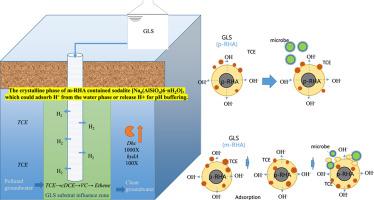当前位置:
X-MOL 学术
›
Environ. Pollut.
›
论文详情
Our official English website, www.x-mol.net, welcomes your feedback! (Note: you will need to create a separate account there.)
Bioremediation of trichloroethylene-contaminated groundwater using green carbon-releasing substrate with pH control capability
Environmental Pollution ( IF 8.9 ) Pub Date : 2024-03-15 , DOI: 10.1016/j.envpol.2024.123768 Hsin-Chia Lee , Ssu-Ching Chen , Yih-Terng Sheu , Chao-Ling Yao , Kai-Hung Lo , Chih-Ming Kao
Environmental Pollution ( IF 8.9 ) Pub Date : 2024-03-15 , DOI: 10.1016/j.envpol.2024.123768 Hsin-Chia Lee , Ssu-Ching Chen , Yih-Terng Sheu , Chao-Ling Yao , Kai-Hung Lo , Chih-Ming Kao

|
In this research, a sustainable substrate, termed green and long-lasting substrate (GLS), featuring a blend of emulsified substrate (ES) and modified rice husk ash (m-RHA) was devised. The primary objective was to facilitate the bioremediation of groundwater contaminated with trichloroethylene (TCE) using innovative GLS for slow carbon release and pH control. The GLS was concocted by homogenizing a mixture of soybean oil, surfactants (Simple Green™ and soya lecithin), and m-RHA, ensuring a gradual release of carbon sources. The hydrothermal synthesis was applied for the production of m-RHA production. The analyses demonstrate that m-RHA were uniform sphere-shape granules with diameters in micro-scale ranges. Results from the microcosm study show that approximately 83% of TCE could be removed (initial TCE concentration = 7.6 mg/L) with GLS supplement after 60 days of operation. Compared to other substrates without RHA addition, higher TCE removal efficiency was obtained, and higher sp. (DHC) population and gene (hydrogen-producing gene) copy number were also detected in microcosms with GLS addition. Higher hydrogen concentrations enhanced the DHC growth, which corresponded to the increased DHC populations. The addition of the GLS could provide alkalinity at the initial stage to neutralize the acidified groundwater caused by the produced organic acids after substrate biodegradation, which was advantageous to DHC growth and TCE dechlorination. The addition of m-RHA reached an increased TCE removal efficiency, which was due to the fact that the m-RHA had the zeolite-like structure with a higher surface area and lower granular diameter, and thus, it resulted in a more effective initial adsorption effect. Therefore, a significant amount of TCE could be adsorbed onto the surface of m-RHA, which caused a rapid TCE removal through adsorption. The carbon substrates released from m-RHA could then enhance the subsequent dechlorination. The developed GLS is an environmentally-friendly and green substrate.
中文翻译:

利用具有pH控制能力的绿色释碳基质生物修复三氯乙烯污染地下水
在这项研究中,设计了一种可持续基质,称为绿色持久基质(GLS),其特点是乳化基质(ES)和改性稻壳灰(m-RHA)的混合物。主要目标是利用创新的 GLS 缓慢碳释放和 pH 控制,促进受三氯乙烯 (TCE) 污染的地下水的生物修复。 GLS 通过均质大豆油、表面活性剂(Simple Green™ 和大豆卵磷脂)和 m-RHA 的混合物配制而成,确保碳源的逐渐释放。水热合成用于m-RHA的生产。分析表明,m-RHA 是均匀的球形颗粒,直径在微米级范围内。微观研究结果表明,手术 60 天后,补充 GLS 可以去除约 83% 的 TCE(初始 TCE 浓度 = 7.6 mg/L)。与未添加RHA的其他基材相比,获得了更高的TCE去除效率和更高的sp。添加 GLS 的微观世界中也检测到了 (DHC) 群体和基因(产氢基因)拷贝数。较高的氢浓度促进了 DHC 的生长,这与 DHC 种群的增加相对应。 GLS的添加可以在初始阶段提供碱度,以中和底物生物降解后产生的有机酸造成的地下水酸化,有利于DHC的生长和TCE脱氯。 m-RHA 的添加提高了 TCE 去除效率,这是由于 m-RHA 具有类沸石结构,具有更高的表面积和更低的颗粒直径,因此,它产生了更有效的初始去除率。吸附作用。因此,大量的TCE可以吸附到m-RHA的表面上,从而通过吸附快速去除TCE。 m-RHA 释放的碳底物可以增强随后的脱氯作用。所开发的GLS是一种环保绿色基材。
更新日期:2024-03-15
中文翻译:

利用具有pH控制能力的绿色释碳基质生物修复三氯乙烯污染地下水
在这项研究中,设计了一种可持续基质,称为绿色持久基质(GLS),其特点是乳化基质(ES)和改性稻壳灰(m-RHA)的混合物。主要目标是利用创新的 GLS 缓慢碳释放和 pH 控制,促进受三氯乙烯 (TCE) 污染的地下水的生物修复。 GLS 通过均质大豆油、表面活性剂(Simple Green™ 和大豆卵磷脂)和 m-RHA 的混合物配制而成,确保碳源的逐渐释放。水热合成用于m-RHA的生产。分析表明,m-RHA 是均匀的球形颗粒,直径在微米级范围内。微观研究结果表明,手术 60 天后,补充 GLS 可以去除约 83% 的 TCE(初始 TCE 浓度 = 7.6 mg/L)。与未添加RHA的其他基材相比,获得了更高的TCE去除效率和更高的sp。添加 GLS 的微观世界中也检测到了 (DHC) 群体和基因(产氢基因)拷贝数。较高的氢浓度促进了 DHC 的生长,这与 DHC 种群的增加相对应。 GLS的添加可以在初始阶段提供碱度,以中和底物生物降解后产生的有机酸造成的地下水酸化,有利于DHC的生长和TCE脱氯。 m-RHA 的添加提高了 TCE 去除效率,这是由于 m-RHA 具有类沸石结构,具有更高的表面积和更低的颗粒直径,因此,它产生了更有效的初始去除率。吸附作用。因此,大量的TCE可以吸附到m-RHA的表面上,从而通过吸附快速去除TCE。 m-RHA 释放的碳底物可以增强随后的脱氯作用。所开发的GLS是一种环保绿色基材。



























 京公网安备 11010802027423号
京公网安备 11010802027423号